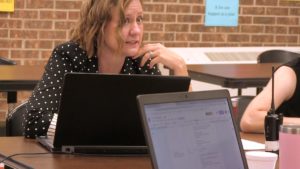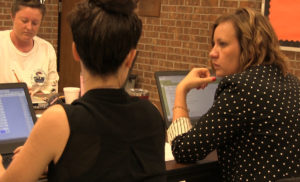By Sharon Kebschull Barrett, also published by EdNC, April 8, 2020
During the coronavirus crisis—and any future periods of at-home teaching and learning—rural school districts face special challenges. In North Carolina’s Edgecombe County Public Schools, Multi-Classroom Leader® Amy Pearce said in a recent interview, two keys to taking care of students will be schoolwide consistency and a focus on taking care of stressed teachers.

Pearce, a multi-classroom leader for a math team of three teachers and a reach associate at North Edgecombe High School, said her rural school’s educators avoid “online” or “remote” learning, instead saying they have a “continuum of instruction” plan. Of their 200 students, about 70 lacked devices or internet access after schools shut down. Those students had to get packets of work delivered by school buses that also delivered food.
“That’s the biggest challenge that we’re having now. If we could go fully remote and knew that our kids had full access to those resources, we could really do some dynamic things with this remote learning, but it’s trying to figure out where that balance is in equity—planning for students with online access versus those who only have access to paper packets,” said Pearce, an Opportunity Culture® Fellow.
Even figuring out how to return packets safely posed challenges. Although some teachers had students send photos of their work, not all students could do that.
But the school, which recently celebrated its third straight year of exceeding student learning growth expectations, and its leadership team under Principal Donnell Cannon is moving quickly to confront its challenges.
Pearce said they were pleased to see the strong relationships teachers previously formed with students paying off now.
“Our teachers are spending a lot of time on calling and texting kids,” she said. “A lot of kids, especially high school kids, don’t want to reach out to an adult and say I need this—but I’ve just been amazed at how many of our kids are reaching out to our teachers and saying, ‘I need x-y-and-z, this is what I don’t have,’ because you don’t see that all of the time, because they want to kind-of keep those things safe and protected for their families. So it was a testament to the relationships and the work we’ve done over the past two or three years.”

After an initial week for the staff to begin planning for an extended at-home period, the school’s leadership team quickly returned to its schedule of regular planning and professional development meetings. Continuing what worked has been a common theme in recent interviews with Opportunity Culture® Fellows about the sudden shift to distance learning.
“Right before everything happened, we did our first session on what does it mean to be a culturally responsive teacher; I felt like we needed to still build on that,” Pearce said. “The reality is that we’re eventually going to be back in front of our kids, and we need to continue to build ourselves professionally. … I think it kind of helps maintain some normalcy as well—I think it’s important that we’re doing these meetings together, because our teachers need something to hang on to as well.”
Students also want to maintain routines, she said. “The exciting thing is our kids want this work, like ‘I finished this; when am I getting my packet, when is the next thing?’ Our kids need that normalcy, too.”
As districts and schools make plans for distance learning long-term, Pearce says to consider:
—Reducing the tools teachers need. Echoing MCL Tu Willingham, Pearce said schools need consistency in what tools teachers are expected to use, and they need to keep the options narrow, to avoid overwhelming teachers and their students.
—Keeping all necessary information and documentation consistent and in one spot. North Edgecombe’s online “survival folder” lets teachers quickly find what they need throughout the year (such as parent contacts, handbook, school plans). Added for the crisis are two simple spreadsheets of details on each student and what assignments each student has, with due dates, for every teacher, so that packets are easy to create for students still lacking online access.
Students also got a document with every teacher’s contact information, and all teachers use the same form for assignments, to avoid overwhelming students.
“When we begin a school year in the summer, we identify what are our systems, what are the things that are consistent? “ Pearce said. “I think that’s the biggest thing that has to happen for this remote learning as a school—what are our systems that we’re going to use, how are we going to communicate, what is going to be communicated? We, a lot of times, talk about schoolwide behavior management systems, like, these are the expectations in every class. We need schoolwide remote learning expectations; these are the things that are across all courses, across all classes, it has to be consistent for kids.”
—Staying tuned in to teachers’ mental health needs. This may be the most important piece, Pearce said. “There are a lot of emotions that our educators are feeling right now. So how do we support our team in this moment?”
In a recent meeting, many colleagues expressed a sense of loss. “A lot of us were on this track to doing great things and have these great plans, and those are paused,” she said. “They’re feeling a loss right now. Some educators might be feeling like, ‘What is my role now? Am I important now?’ Some are feeling guilt, like ‘I’m getting paid right now, am I doing enough to get paid while others around me and friends around me aren’t? What is enough in this time of remote learning and working at home?’ [And] where is that balance of doing your work for your kids at school but also being there for your personal kids, at home, who are feeling the stress? We have a lot of educators that are parents too.”
And finally, for multi-classroom leaders and other team leaders, such as principals, “focus needs to be brought to ‘how do you help take care of your team who are feeling these feelings, while they are trying to take care of the kids that they serve?’”
This column is one of a series of interviews about the COVID-19 shift to at-home teaching:
- For This MCL, A Week of Team Planning and Parenting
- In Georgia, Leading a Team on Distance Teaching and Caring
- Keep Doing What Worked: Advice for At-Home Learning
- In Charlotte, Keeping Connected to 212 At-Home Students
- Spreading Support in Vance County During At-Home Learning
- From Start to Finish, A Focus on Relationships During At-Home Learning
- High-Touch At-Home Learning? That’s the Plan in Indianapolis School
- In Arizona, Turning Vulnerabilities Into Strengths as Teaching Goes Home
This column was also published by EdNC.org.
Note: Public Impact® and Opportunity Culture® and Multi-Classroom Leader® are registered trademarks; MCL™, and Reach Associate™ are trademarked terms, registration pending.
